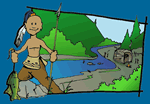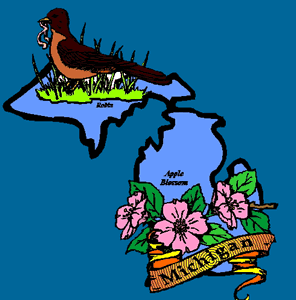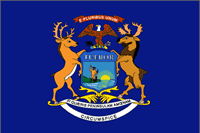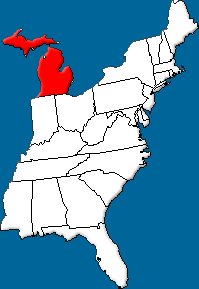


Geography and Landforms:
The state of Michigan consists of two peninsulas separated by the Straits of Mackinac. The Upper Peninsula lies between Lake Michigan and Lake Superior. The Lower Peninsula is bordered on the West by Lake Michigan and on the East by Lake Huron, Lake Erie, and two rivers, the Detroit and the St. Clair.
|
 History:
The French explorer Etienne Brule was the first European to reach the Michigan region. Brule landed at the narrows of Sault St. Marie in 1620 and named the area New France. In 1634, Jean Nicolet was sent by France to explore sections of the Upper Peninsula, and find a route to the Pacific Ocean.
|
 Economy:
Michigan became the birthplace of the automobile industry in 1899 when Ransom Olds started the Olds Motor Works in Detroit. By 1903, Henry Ford had established the Ford Motor Company in Dearborn. Soon Detroit became known as the automobile capital of the world. The manufacture of automobiles is still Michigan's chief industry. Other manufactured products include metal products, chemicals, food products and non-electric machinery.
|
 First Inhabitants:
When European explorers arrived in the Michigan region in the early 17th century it was already populated by Algonkian Indians. The Chippewa and Menominee tribes lived in the Upper Peninsula, while the Miami, Ottawa, and Potawatomi occupied the Lower Peninsula. The name "Michigan" actually came from the Chippewa word "Michigan," which means "great lake."
|
Books Related To MichiganBucking the Sarge - Christopher Curtis Bud, Not Buddy - Christopher Curtis Jam and Jelly by Holly and Nellie - Gloria Whelan Kyle's Island - Sally Derby The Log Cabin Christmas - Ellen Howard M is for Mitten: A Michigan Alphabet - Annie Appleford Memories of Summer - Ruth White Mr. Chickee's Funny Money - Christopher Curtis Mrs. Mack - Patricia Polacco When Lightening Comes in a Jar - Patricia Polacco |
Famous Citizens:
|
| Capital: | Lansing |
| Entered Union: | January 26, 1837 |
| Population: | 9,909,877 |
| Area | 96,716 |
| Bird | Robin |
| Flower | Apple Blossom |
| Nickname: | The Wolverine State, Great Lakes State |
| Governor | Rick Snyder |
Places to Visit in Michigan: (Click the links to learn more.)
|



